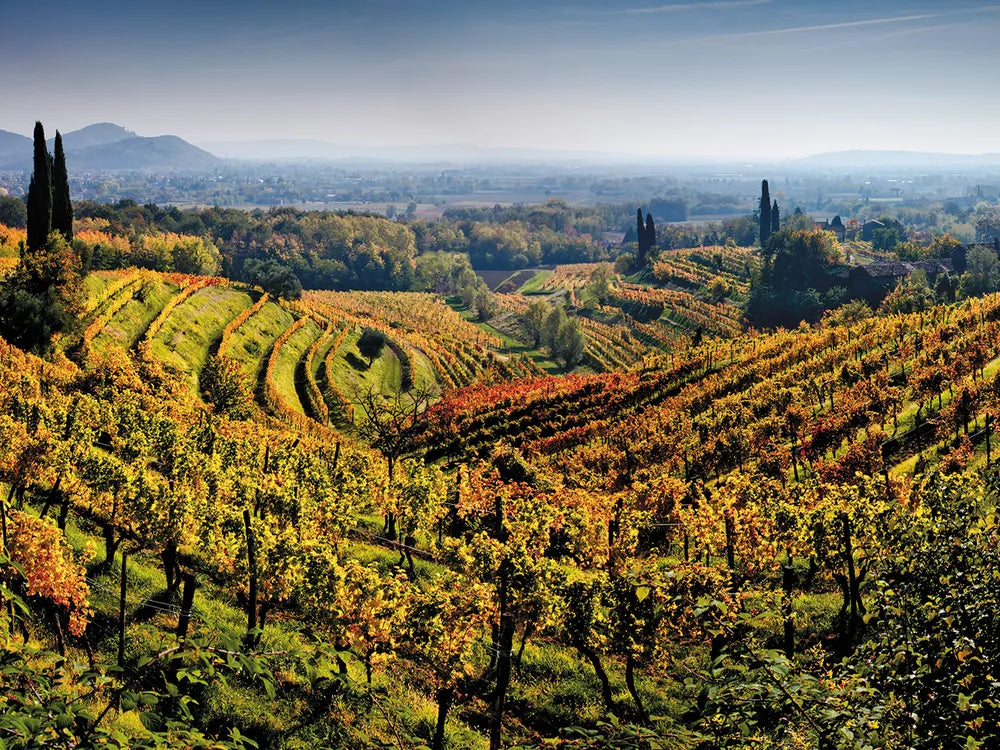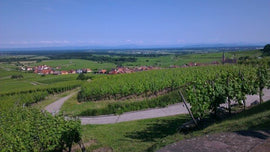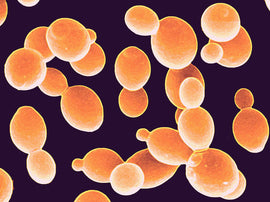Friuli - Venezia Giulia
Hate to have to start the new year with an apology, but as I did not envision finishing 2024’s IWC tour in the early days of 2025, it feels necessary to say: sorry for being so tardy. In my defense, overseas vino can be a capricious deity, and all the more so as you trellis the knottier branches of old vine, low-yield, small production stuff, like we mostly do here. I won’t bore you with the details but long story short: this (last) month’s club encountered an inordinate number of difficulties, went through a few different iterations, on its way to the (hopefully) successful resolution you have in your hands now.
The destination however, was never in doubt. Friuli is arguably Italy’s most unpredictable and widescreen wine region, so perhaps both the detours and the eventual happy arrival were to be expected in retrospect. Bordering Austria to north, Slovenia to the east, Veneto to the west and facing the Adriatic Sea to the south, Friuli - Venezia Giulia (henceforth abbreviated as Friuli) is the hinge that connects Italian peninsula with the Eastern Europe and Asia; since antiquity, it has been a highly contested crossroads of cultures, languages, religions and ethnicities. The city of Trieste in particular has spent centuries as one of Europe’s busiest entrepôts, whether as part of the Roman, Holy Roman, Austrian, French, and Austro-Hungarian empire(s), a free-standing Free City or, finally, Italy. (And that’s a partial list.)
All this international intrigue has created a sui generis wine scene populated by stranded ex-pats like Cabernet Sauvignon, Merlot and Sauvignon Blanc, obscure local varietals, famous grapes with unfamiliar accents (Ramato style Pinot Grigio) and Peter Lorre type growths of uncertain origin/motivation. This month we are tilting towards the latter, but ultimately, the thrill of any bottle that says “Friuli” on it is that you can still never be quite sure where it’s coming from.
For instance, Giampaolo Venica, who makes our white this month, is a scion of Venica e Venica, one of the most venerable wineries in the region, but he has spent his professional life studying with one of most the most famous Rhone vignerons on the planet, Jean-Louis Chave. His Piccolo Bianco is consequently a tribute to Croze Hermitage Blanc that blends Friulain favorites Ribolla Gialla and Friulano, rather than the traditional French varietals Grenache Blanc, Marsanne or Roussanne. It is however, aged in oak (very rare for a Frulian white) and, as in Hermitage, each plot is vinified separately and evaluated for quality to decide how blending can achieve more complexity depending on the vintage.
The red comes from an area called Villanova del Judrio, not far from Trieste. The Judrio, or Judri in Friuli dialect, is a river originating on the Kolovrat Plain marking the border between Italy and Slovenia, where it is known as Idrija. The name of the estate, Vignai da Duline, derives from dolina, which in Friuli dialect is a valley—in this case, the riverbank of the Judrio. The couple who operate Duline, Lorenzo Mocchiutti and Federica Magrini, both have deep roots in the region, farming vineyards that have been in Lorenzo’s family since 1920. Neither of them intended to go into viticulture (literature professor and medical student, respectively) but since taking over in the late 90’s, they have proved to be singularly inspired and conscientious stewards of the mostly neglected land they inherited. Some of the vines here are over 100 years old, and due to Lorenzo’s grandfather’s stinginess, none of them have ever known herbicide; Lorenzo and Frederica have accordingly focused on permaculture, and old vine restoration and sustainability, with striking results. Their wines, the flagship Refosco featured here very much among them, have garnered a cult following and are as precise and unique as the unlikely circumstances that led to their creation.
|
Dalia Maris Piccolo Bianco 2022 |
|
|
Region: Friuli-Venezia Giulia, Italy |
About the Winery: Dalia Maris takes its name from the Latin phrase “Stella Maris”, which is an expression meaning “look to the north star”; a phrase that encapsulates the freedom to navigate and signals hope. Dalia is Giampaolo’s grandmother’s name. As those close to him know, Giampaolo has spent several harvests with Jean-Louis Chave in St. Joseph in the Rhone Valley, heading straight to Hermitage directly after finishing harvest at Venica in 2017, 2018 and 2019. Looking to the Rhone Valley for inspiration, Giampaolo began to study more closely the wines he admires in Friuli and realized that many aren’t even made from native varieties, but from Chardonnay and Sauvignon that often see oak aging. Dalia Maris aspires to be something completely different, a unique take on what Giampaolo thinks the local grapes can express: power balanced by ripeness with the distinct, salty minerality that speaks to Friuli and creates a crunchiness in texture. While some would say that he is swimming against the tide with this project, Giampaolo feels that his time has come to lead and not follow. His first vintage was 2020. About the Winemaking: Buttrio is a sub zone within Friuli’s Colli Orientali. It is arguably the warmest wine producing area of the region (average annual temperature between 50’ and 70’ F) with vineyards overlooking the village of Buttrio. Soils alternate layers of marl and thin sheets of sandstone which lend to wines with great body and refined tannic structures that tend to have great aging potential. All farming is biodynamic, and harvest is carried out manually. The fruit comes from field blends (80% Friulano, 20% Ribolla Gialla) of several small parcels, ranging from 60 to 80 years in age. The Dalia Maris wines are aged in barrels from the same cooperage as Chave, Tonnellerie Mercurey, with whom Jean-Louis has a long-standing relationship. Seeing as the barrels are allocated, Jean-Louis sources them for Giampaolo when possible for the Dalia Maris project. The specific barrique used for Chave’s Hermitage Blanc, which Giampaolo sees fit for the Dalia Maris wines, has high quality oak and a light toast. Powerful varieties like Marsanne and Roussanne benefit greatly from the new barrels, just like Friulano. Tasting Notes: Floral aromas on the nose lead to a rich and dense palate of orchard and tropical fruit, garnished with sliced almond and seasoned by a salty minerality. |
|
Winemaker: Giampaolo Venica |
|
|
Price per bottle / Price per case $46.99 $507.50 |
|
|
Suggested Food Pairing: Lobster rolls, butternut squash on ricotta toast, cauliflower puree, shrimp biryani
|
|
|
Vigna da Duline Refosco dal Penduncolo Rosso “Morus Nigra” 2019 |
|
|
Region: Colli Orientali, Friuli, Italy |
About the Winery: In the late 1990s Lorenzo Mocchiutti and wife Federica Magrini inherited a few hectares of vines from Lorenzo’s grandfather. These vineyards, mostly neglected for decades, were planted primarily with old vines of local grape varieties like Tocai Giallo, Malvasia Istriana, Tocai Fruilano, and Schioppettino, as well as more common varieties like Pinot Grigio, Chardonnay, and Merlot. Today, their holdings cover seven hectares divided between hillsides and flatlands, including Ronco Pitotti, one of the oldest hillside vineyards in Friuli, with vines dating back to the 1920s. Their respectful, holistic approach to vineyard management is summed up in their philosophy of “No Trimming the Shoots” and “No Herbicides.” Though it is generally accepted that vines are trimmed of excess leaves or fruit to concentrate a vine’s efforts toward healthy bunches of grapes, Lorenzo and Federica let their vines find their own balance, choosing not to trim any of their vines. In addition to this unconventional practice, they do not use herbicides to prevent growth of unwanted vegetation between rows of vines. Instead they plant a type of alfalfa, erba medica, that when cut acts as a natural fertilizer. Lorenzo and Federica’s significant efforts in the vineyard combine with hand-harvesting, two sortings of the grapes, and natural fermentation to create age-worthy wines of great purity. About the Winemaking: The strictly manual harvest takes place in the second half of September. Once in the cellar, the selected grapes are destemmed and softly pressed, followed by maceration for approximately 28 days. The must is then left to ferment in French oak barriques with the sole use of indigenous yeasts. Regarding refinement, the wine rests for approximately eleven months in barriques and oak barrels. After blending and bottling, the wine rests for another fifteen months in the bottle before being placed on the market. Tasting Notes: Intense ruby red. The aroma is elegant and complex, with pleasant notes of red fruits that leave room for sensations of undergrowth to close with delightful spicy puffs. Fresh and harmonious on the palate, this Refosco from the Vignai Da Duline winery is well balanced with a good correspondence between aromas and flavor and a nice long and persistent finish. |
|
Winemakers: Lorenzo Mocchiutti & Federica Magrini |
|
|
Price per bottle / Price per case $40.99 $442.70 |
|
|
Suggested Food Pairing: barbecued and grilled meats, pork fillet with fruit sauce (plum or apple), deep tomato sauces, and roasted carrots. |
|
Branzino brasato con spugnole (Braised sea bass with morel mushrooms)
(Serves 6)
Ingredients
|
|
|
In a sauté pan get the oil hot over medium heat. Add the onion, carrot and celery, let smother for 5 minutes. Raise the heat to medium-high and sear the sea bass both sides until the skin is crisp. Add the vegetable stock. Add the Brussels sprouts leaves, morels, salt and fresh grind pepper. Cover and braised to low-medium heat for 15 minutes. Add heavy cream and cook covered for another 10 minutes. Serve with toasted rye bread. This dish pairs well with both wines.





